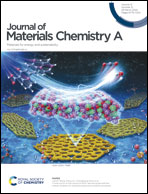Enhanced PEMFC performance through high O2 permeation and proton conductive electrospun nanofiber electrodes with unique ionomer construction†
Abstract
A high-quality Pt/C catalyst/ionomer nanofiber catalyst layer (NFCL) was fabricated via an electrospinning method, with a performance that was 9.4% higher than that of a conventional particle-stack catalyst layer counterpart fabricated via an ultrasonic spray method (a power density of 1235 mW cm−2vs. 1128 mW cm−2 at 2 A cm−2 with a cathode loading of 0.15 mgPt cm−2). The area of the membrane electrode assembly was 300 cm2, which is suitable for application in polymer electrolyte fuel cell-based commercial vehicles. To our knowledge, this is the first time that an electrospinning NFCL with such a large area has been reported. Given its excellent H2–air performance under practical commercial fuel cell vehicle operating conditions, this work demonstrates significant potential for incorporating such an advanced nanofiber layer in commercial fuel cell vehicles. The focus of this work is to investigate how a nanofiber morphology benefits electrode mass transport and proton conductivity and, thereafter, to suggest the mechanism of how the NFCL could improve performance. Knudsen diffusion resistance in catalyst layer pores and local O2 permeation resistance in ionomer films were measured and calculated to distinguish the key factors for the improved mass transport properties of the NFCL. In situ electrochemical diagnostics (electrochemical impedance spectra, normalized electrochemically active surface area, and mass activity) and ex situ microscopy characterization (scanning transmission electron microscopy with energy-dispersive X-ray spectroscopy, atomic force microscopy, and X-ray diffraction) were carried out to analyze catalyst layer morphology and its contribution to the cell performance. Well-distributed and thin ionomer films within catalyst/ionomer fibers, ionomer nanofibers along the length of catalyst/ionomer fibers, and ultra-exposed active sites were the main reasons for an improved proton conductivity and oxygen reduction reaction kinetic activity as well as the reduced O2 transport resistance of the NFCL. Although the inter- and intra-nanofibers of the pores showed a moderately higher gas transport resistance compared to the particle-stack catalyst layer, it had a negligible negative influence on cell performance.



 Please wait while we load your content...
Please wait while we load your content...